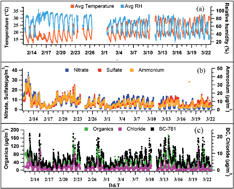Highly time resolved chemical characterization of submicron organic aerosols at a polluted urban location†
Abstract
Non-refractory submicron (NR-PM1) aerosols were measured during the late winter period (February–March) via an Aerodyne High Resolution Time of Flight Aerosols Mass Spectrometer (HR-ToF-AMS) along with Black Carbon (BC) and trace gasses in an industrial city, Kanpur, situated in the Gangetic Plain (GP) of India. The composition of NR-PM1 aerosols was dominated by organics (54%), followed by inorganics (36%), and BC (10%). Source apportionment via Positive Matrix Factorization (PMF) of AMS measured organic aerosols (OAs) revealed 6 factors. Factors are identified as 2 types of oxidized organic aerosols (OOAs), 2 types of biomass burning organic aerosols (BBOAs), freshly emitted hydrocarbon-like organic aerosols (HOAs) and oxygenated primary organic aerosols (OPOAs). A substantial increase in relative OOA contributions (200%) and O/C ratio (26%) has been observed from the high loading events (HLE) to the low loading events (LLE). Back trajectory analysis indicated that the study location received contributions from regional and long-range transported aerosols. OA composition and evolution during this study period were also very different from those observed during a fog influenced peak winter period of December–January. This is the first study to present detailed aerosol composition during the late winter period in India highlighting the changes in OA composition and chemistry within the same winter season.


 Please wait while we load your content...
Please wait while we load your content...